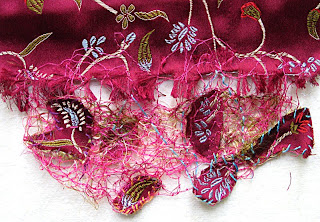In the first part I looked at possibilities using frayed edges and discovered that the Chinese fabric finally came into it's own as it frays really beautifully showing all the colours use in the weaving process.
I took my inspiration from the historical research at the beginning of this chapter, thinking about Tudor dress and the deconstruction of surviving textiles of the period.

3/8/1
In the 2 right hand samples I was thinking of the dress decoration of the late 16th century, and in the left sample I cut up pieces of the Chinese fabric and then distressed them and stitched them to a rich crushed velvet with hand dyed silk, a very therapeutic sample to produce.

3/8/2
Ruffles were next and I was very interested to discover that if you gather a folded bias strip ( as instructed) when you pull up the gathers you have a rose!
In the other 3 samples I tried out a graduated shape and frayed the edge, a decorative edge, and bunches of gathers with silk organza and rough cut Chinese fabric.

3/8/3
Next were flounces and I discovered that if you cut the outside edge in an interesting shape it changes the flounce to something quite unusual.

3/8/4
The next part was creating an edge with water soluble media.

3/8/5
Lastly it was a return to a previous exercise where I worked an edge on paper and have now interpreted it as a sample.

3/8/6

3/8/7
Firstly I worked a very loose free machine embroidery structure on water-soluble media. Then I incorporated pieces of the original fabric and then worked in the frayed threads that I'd pulled from the edge. Finally I hand worked some running stitches in hand dyed silks before washing away the water soluble media.

3/8/8
wow you are steaming ahead now! love your samples and particularly the colours of the chinese fabric.
ReplyDeleteWhat gorgeous samples. More than just samples even.
ReplyDelete